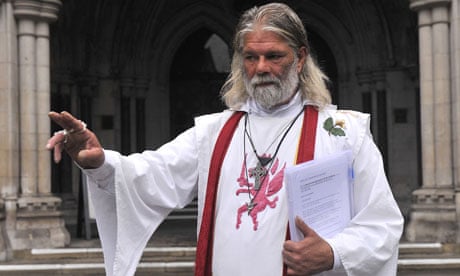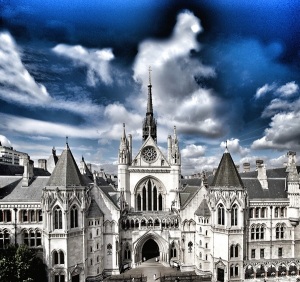
Arthur on the steps of the Royal Courts of Justice in in 2011, attempting to get a judicial review into returning cremated human remains to Stonehenge
After St Paul’s we walked to the Royal Courts of Justice on the Strand, where King Arthur read out the Royal Proclamation forgiving debt:
“I, Arthur Uther Pendragon, having been raised Druid King of Britain on the Coronation Stone at Kingston upon Thames in January 1998, this being the first day of the Celtic New Year according to some calculations, do declare a Clean Slate, and a state of economic renewal, according to powers vested in the ancient Kings.
“Just as the Sun returns to the same position on the horizon each year, and the Moon revolves around the Earth; just as the land is revived season by season, and the Earth begins anew again; just as birds return to their nests and salmon to their breeding waters; just as Winter gives way to Spring and Spring gives way to Summer, so the money cycle must be ever renewed and returned to a state of economic equilibrium.
“Let all debts be forgiven. Let all forfeitures be returned. Let those who were dispossessed reclaim their customary possessions. Let the records be wiped clean and the Jubilee declared throughout the lands, as it always was. Let those who are enslaved by debt be made free. Let those who are brought low by financial burden have the weight lifted from them. Let the power vested in government to create money be used for the benefit of all the people, and not just the favoured few.
“Let a new bank holiday begin, a holiday from banks. Let the banks be made accountable to those they have indebted. Let their privileges be revoked. Let those who hoard money be cured of their addiction. Let the money be free to circulate as it wills. Let it flow freely throughout the economy, like irrigation in a barren wasteland. Let the financial canals be opened and the land be brought to life again.
“We are planting a seed here in the heart of the City of London, City of Cities, the birthplace of the old economy, where all debt is created, and to which all debt must be returned.
“It is the seed of monetary Justice, the seed of hope for a bright new future, the seed of the new debtless economy, where usury and interest bearing debt give way to sovereign money in the hands of the people, and all of the people are free.”
He read it from the steps of the Royal Courts, from a scroll which he had fashioned himself, and which added proper gravitas to the reading. The whole thing was witnessed by the assembled company, the forty or so people who had accompanied us on our journey, after which the scroll was sealed with wax from the burning candle which had been lit in the concourse outside St Pauls, and then carried here.
The Royal Courts is an extraordinary building. It’s Victorian Gothic, in the same mould as the Houses of Parliament, only even more elaborately picturesque. It’s like someone’s fantasy of a Fairy Castle brought to life, with turrets and towers and vaulted arches by the dozen. You can almost imagine a giant fee-fi-fo-fumming in front of its Cathedral-sized front door, as an enchanted princess lowers her tresses from one of its many turrets, to allow a prince to ascend.
It is the perfect place, in other words, for a mythical King to read out a proclamation of great spiritual and political significance.
Actually Arthur is very familiar with the Royal Courts of Justice, having been here many times before.
Most recently, in 2011, he was here attempting to get a judicial review into returning the cremated human remains, dug up by archaeologists at Stonehenge in 2008, returned to their previous resting place near the stones.
He was also here in 1996, during the Newbury bypass protests, when he was brought under police escort from Bullingdon Jail in Oxfordshire, where he had been incarcerated for refusing bail conditions, in order to fight an injunction against him attempting to ban him from going anywhere within 100 metres of the contractors’ goods or chattels anywhere in the world.
They were claiming – falsely – that he was planning to go to Holland to lock-on to one of their cranes.
Each of the petitioners – the Highways Agency, the Department of Transport and Costain, the contractor – was represented by a “Learned Barrister” and his team, while Arthur represented himself.
So you can picture the scene if you like: the majestic court room, with its columns and arches and vaulted ceilings, with its wooden panels, its shields and plaques; the barristers in their wigs and robes, flapping about like crow’s wings, the judge in his shoulder length wig and ermined robes, raised on his platform; the police and prison officers in their uniforms; and Arthur, in the dock, in his battle-frock, with his circlet about his head, representing himself as the reincarnation of a Dark Ages Battle Chieftain, claiming Druid immunity on the battlefield.
Yes, that’s right, say it again – “Druid immunity on the battlefield” – quoting from the Classical writers, Strabo and Diodorus, from the first century BC.
The Learned Barristers laughed out loud when they heard that, but were soon silenced when the Judge adjourned the case to seek legal clarification on the matter.
On his return, the Judge ruled that Arthur was correct, but as he couldn’t show that Druids had practised such a right prior to the reign of Richard I, in and around Newbury according to local custom, it did not apply. However he did agree with Arthur that the conditions of the injunction were beyond his jurisdiction, applying not just to the UK, but to the rest of the world. He also agreed that they were impracticable. As Arthur pointed out, he could be driving anywhere in Britain and come upon temporary traffic lights or traffic cones belonging to Costain, and break the injunction without knowing it. In other words, put simply, Arthur won the case, beat the injunction, and was free to go on protesting at Newbury.
The ruling about Druid immunity on the battlefield being based on local custom, by the way, could also have been argued on the basis of national custom: which leaves the door open to the possibility of someone making the claim again at some point in the future. And if ever anyone feels like trying it out, they can refer to this court case as the precedent.
This is one of the things about Arthur that makes him so fascinating. People who don’t know him or who have never met him, often think he’s crazy: at best eccentric, at worst, certifiably insane. The man you meet, however, is just an old fashioned, working class biker-dude turned Druid: a bit rough around the edges, but obviously intelligent.
It’s the use he puts his assumed identity to that makes the difference; and, let’s face it, he’s not the only one with a penchant for fancy-dress. Those Learned Barristers too – the Judge, the court officials, the police and prison officers – all of them wear distinctive clothing to define their office.
 The court room too is full of symbols. Take a look at the plaque on display in every court in the land, the famous “Lion and the Unicorn”: it’s a shield with the rampant lion on one side and a unicorn on the other. The unicorn has a crown around its neck, which is chained to the ground. What does that mean? Arthur says it represents warrior energy unleashed, and magical energy chained. Whatever it is, it is a potent symbol of British imperial power.
The court room too is full of symbols. Take a look at the plaque on display in every court in the land, the famous “Lion and the Unicorn”: it’s a shield with the rampant lion on one side and a unicorn on the other. The unicorn has a crown around its neck, which is chained to the ground. What does that mean? Arthur says it represents warrior energy unleashed, and magical energy chained. Whatever it is, it is a potent symbol of British imperial power.
Arthur pits his own symbols against these: the rampant dragon on his chest, the silver crown with a flying dragon in the centre, the pentagram, the Celtic cross, the sword, which he insists on swearing upon in place of the Bible, and which was once brought to Reading Crown Court with a motorcycle escort, blue lights flashing, from Charring Cross Police Station on the order of the Judge. And if Arthur claims, as he does, that it is the “Sword of Britain” and the Judges allow him to swear on it as such, then doesn’t this make it legally true; legally binding in a British Court of Law?
It is through these symbols that he is claiming an authority which precedes and overrides that of the British State. And it is an authority which the Judges – themselves most often steeped in their own form of magical practice as Freemasons – almost invariably recognise.
Let’s face it: it is all symbolic.
Legal authority, power, status, wealth, democracy, the Crown: all of these are expressed in symbolic language.
And money too: those intricately designed notes we carry around with us, with the Queen’s head on one side and national folk heroes on the other; with the “promise to pay the bearer on demand”, which, when you put it into practice, means merely swapping one identical note for another.
You can’t get more deeply symbolic than money: a note which symbolises itself.
What Arthur does is to remind us that all real authority comes from ourselves.
Arthur has elaborated his own status into a recognisable system, a set of symbols by which we know him. But we don’t have to wear a white robe and a crown to be known and recognised for who we are; we simply have to know in ourselves that everything claiming authority over us is symbolic and create our own symbols in return.
And, this, of course, is what we’ve been up to all day. We’ve been addressing the world of money and finance with the symbols of our own creative power.
This is what magic is all about.
Can it change the physical world?
Maybe not.
But it does change the symbolic world, the psychological world. It changes those who practice it. It opens up the doors of the psyche to other possibilities, to other ways of being.
It unleashes imagination into the world. It creates a world in the imagination. It allows us to step aside from the world that is imposed upon us – through the financial system, the class system, through war and propaganda – and to look at it with fresh eyes, with a fresh mind, with intelligence, wit and sensitivity, in the hope that we can transform the world, and begin to make it new again.

